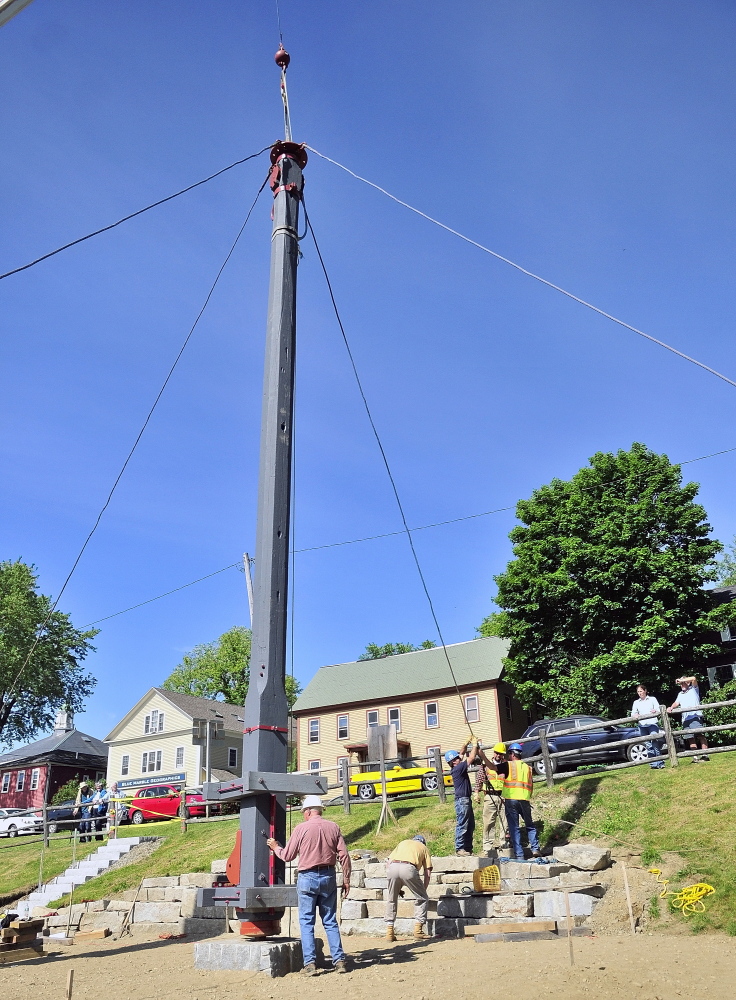In the 1800s, wooden cranes were used at the Hallowell waterfront to move blocks of granite onto schooners along the Kennebec River, bound for destinations along the eastern seaboard.
Now, a crane discovered in an old quarry in Augusta 30 years ago is serving as a monument at the Hallowell Waterfront Park and as a reminder of a major industry for the city. The wooden crane was installed Wednesday as a permanent monument on the grassy hill leading down to the city’s boardwalk after a small group of residents raised around $30,000 for the project.
“We hope people see it as a striking monument and testament to an industry that was so dominant in Hallowell for so many years and contributed so much to all across America,” said Gerry Mahoney, one of the residents who lead the effort. “It should be a source of community pride, and that’s what we were hoping to recognize.”
The crane, with a 37-foot-tall wooden mast and 36-foot-long boom that used to swing around to move the blocks of granite, was found in 1985 in the remains of a small quarry on a KeyBank property on Edison Drive in Augusta. Al Hague, the other Hallowell resident leading the monument effort, worked for KeyBank at the time and recognized the crane’s significance.
Hague, 85, said the crane, which is likely at least 125 years old, was well preserved because it was found on granite blocks, not in the water or mud. The bank displayed it at the KeyBank property for around 20 years before giving it to the city of Hallowell in 2003.
It’s likely one of the last remaining wooden granite cranes, according to State Historian Earle Shettleworth.
“I’m not aware, in my travels across the state, that I’ve seen another crane that has been preserved and used to interpret the history of the quarry industry,” Shettleworth said.
Hallowell, along with the coast and western parts of the state, were exporters of granite from quarries in the 19th century and early 20th century, he said. Granite from Hallowell was so well regarded that one of the leading American architects at the time — Richard Morris Hunt — chose it to build the New York Tribune Building in 1875, Shettleworth said. Many buildings and monuments along the eastern seaboard were built using Hallowell granite, he said.
The granite industry’s heyday was between 1825 and 1925. It fell out of favor when concrete and other lighter materials were used for buildings with steel frame constructions, Shettleworth said.
The Maine State House, built from 1829-1832, is made of Hallowell granite.
In Hallowell, workers brought it from the quarries around the Granite Hill area to cutting sheds along the railroad tracks. The cranes were needed to hoist the large blocks out of the quarries.
City Council approved the installation at the Waterfront Park last year. Hague and Mahoney, along with other volunteers including Nancy McGinnis, solicited donations from individuals and local businesses to raise the funds needed to install the crane.
Around $5,000 to $6,000 is still needed to finish the monument and add landscaping features and signs at the site, Hague said. The boom is currently sitting on granite blocks, but it will eventually be lifted up and attached to the mast.
Hague and Mahoney both worked on the waterfront advisory committee that helped install the bulkhead and boardwalk, and Mahoney, 71, said the hope was always to incorporate a monument for the granite industry in the community known as the Granite City. The two Hallowell men had to prime and paint the crane and took the iron off to sandblast and paint it, he said.
“I just thought it was an artifact that was worthy of preservation,” Mahoney said.
Paul Koenig — 621-5663
Twitter: @paul_koenig
Send questions/comments to the editors.






